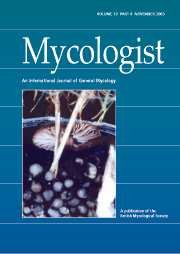Crossref Citations
This article has been cited by the following publications. This list is generated based on data provided by
Crossref.
Tibpromma, Saowaluck
Hyde, Kevin D.
Jeewon, Rajesh
Maharachchikumbura, Sajeewa S. N.
Liu, Jian-Kui
Bhat, D. Jayarama
Jones, E. B. Gareth
McKenzie, Eric H. C.
Camporesi, Erio
Bulgakov, Timur S.
Doilom, Mingkwan
de Azevedo Santiago, André Luiz Cabral Monteiro
Das, Kanad
Manimohan, Patinjareveettil
Gibertoni, Tatiana B.
Lim, Young Woon
Ekanayaka, Anusha Hasini
Thongbai, Benjarong
Lee, Hyang Burm
Yang, Jun-Bo
Kirk, Paul M.
Sysouphanthong, Phongeun
Singh, Sanjay K.
Boonmee, Saranyaphat
Dong, Wei
Raj, K. N. Anil
Latha, K. P. Deepna
Phookamsak, Rungtiwa
Phukhamsakda, Chayanard
Konta, Sirinapa
Jayasiri, Subashini C.
Norphanphoun, Chada
Tennakoon, Danushka S.
Li, Junfu
Dayarathne, Monika C.
Perera, Rekhani H.
Xiao, Yuanpin
Wanasinghe, Dhanushka N.
Senanayake, Indunil C.
Goonasekara, Ishani D.
de Silva, N. I.
Mapook, Ausana
Jayawardena, Ruvishika S.
Dissanayake, Asha J.
Manawasinghe, Ishara S.
Chethana, K. W. Thilini
Luo, Zong-Long
Hapuarachchi, Kalani Kanchana
Baghela, Abhishek
Soares, Adriene Mayra
Vizzini, Alfredo
Meiras-Ottoni, Angelina
Mešić, Armin
Dutta, Arun Kumar
de Souza, Carlos Alberto Fragoso
Richter, Christian
Lin, Chuan-Gen
Chakrabarty, Debasis
Daranagama, Dinushani A.
Lima, Diogo Xavier
Chakraborty, Dyutiparna
Ercole, Enrico
Wu, Fang
Simonini, Giampaolo
Vasquez, Gianrico
da Silva, Gladstone Alves
Plautz, Helio Longoni
Ariyawansa, Hiran A.
Lee, Hyun
Kušan, Ivana
Song, Jie
Sun, Jingzu
Karmakar, Joydeep
Hu, Kaifeng
Semwal, Kamal C.
Thambugala, Kasun M.
Voigt, Kerstin
Acharya, Krishnendu
Rajeshkumar, Kunhiraman C.
Ryvarden, Leif
Jadan, Margita
Hosen, Md. Iqbal
Mikšík, Michal
Samarakoon, Milan C.
Wijayawardene, Nalin N.
Kim, Nam Kyu
Matočec, Neven
Singh, Paras Nath
Tian, Qing
Bhatt, R. P.
de Oliveira, Rafael José Vilela
Tulloss, Rodham E.
Aamir, S.
Kaewchai, Saithong
Marathe, Sayali D.
Khan, Sehroon
Hongsanan, Sinang
Adhikari, Sinchan
Mehmood, Tahir
Bandyopadhyay, Tapas Kumar
Svetasheva, Tatyana Yu.
Nguyen, Thi Thuong Thuong
Antonín, Vladimír
Li, Wen-Jing
Wang, Yong
Indoliya, Yuvraj
Tkalčec, Zdenko
Elgorban, Abdallah M.
Bahkali, Ali H.
Tang, Alvin M. C.
Su, Hong-Yan
Zhang, Huang
Promputtha, Itthayakorn
Luangsa-ard, Jennifer
Xu, Jianchu
Yan, Jiye
Ji-Chuan, Kang
Stadler, Marc
Mortimer, Peter E.
Chomnunti, Putarak
Zhao, Qi
Phillips, Alan J. L.
Nontachaiyapoom, Sureeporn
Wen, Ting-Chi
and
Karunarathna, Samantha C.
2017.
Fungal diversity notes 491–602: taxonomic and phylogenetic contributions to fungal taxa.
Fungal Diversity,
Vol. 83,
Issue. 1,
p.
1.
Golovchenko, Victoria V.
Khramova, Daria S.
Shinen, Naranmandakh
Jamsranjav, Ganbaatar
Chizhov, Alexander O.
and
Shashkov, Alexander S.
2018.
Structure characterization of the mannofucogalactan isolated from fruit bodies of Quinine conk Fomitopsis officinalis.
Carbohydrate Polymers,
Vol. 199,
Issue. ,
p.
161.
Hayova, V.P.
Heluta , V.P.
and
Shevchenko , M.V.
2020.
Fomitopsis officinalis (Polyporales): are there any records of the fungus known from Ukraine?.
Ukrainian Botanical Journal,
Vol. 77,
Issue. 1,
p.
40.
Muszyńska, Bożena
Fijałkowska, Agata
Sułkowska‐Ziaja, Katarzyna
Włodarczyk, Anna
Kaczmarczyk, Piotr
Nogaj, Ewa
and
Piętka, Jacek
2020.
Fomitopsis officinalis: a Species of Arboreal Mushroom with Promising Biological and Medicinal Properties.
Chemistry & Biodiversity,
Vol. 17,
Issue. 6,
Mamaeva, Olga O.
Isaeva, Elena V.
Loskutov, Sergey R.
Petrunina, Elena A.
Fedorov, Vladimir S.
Marchenko, Roman A.
and
Kovalev, I.
2023.
Transformation of plant substrates by fungi Fomitopsis pinicola.
E3S Web of Conferences,
Vol. 390,
Issue. ,
p.
04003.
Gafforov, Yusufjon
Muszyńska, Bożena
Sułkowska-Ziaja, Katarzyna
Tomšovský, Michal
Yarasheva, Manzura
Pecoraro, Lorenzo
Mykchaylova, Oksana
and
Rapior, Sylvie
2023.
Ethnobiology of Uzbekistan.
p.
1237.




